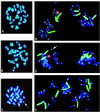Etoposide induces heritable chromosomal aberrations and aneuploidy during male meiosis in the mouse
- PMID: 11274416
- PMCID: PMC31160
- DOI: 10.1073/pnas.061404598
Etoposide induces heritable chromosomal aberrations and aneuploidy during male meiosis in the mouse
Abstract
Etoposide, a topoisomerase II inhibitor widely used in cancer therapy, is suspected of inducing secondary tumors and affecting the genetic constitution of germ cells. A better understanding of the potential heritable risk of etoposide is needed to provide sound genetic counseling to cancer patients treated with this drug in their reproductive years. We used a mouse model to investigate the effects of clinical doses of etoposide on the induction of chromosomal abnormalities in spermatocytes and their transmission to zygotes by using a combination of chromosome painting and 4',6-diamidino-2-phenylindole staining. High frequencies of chromosomal aberrations were detected in spermatocytes within 64 h after treatment when over 30% of the metaphases analyzed had structural aberrations (P < 0.01). Significant increases in the percentages of zygotic metaphases with structural aberrations were found only for matings that sampled treated pachytene (28-fold, P < 0.0001) and preleptotene spermatocytes (13-fold, P < 0.001). Etoposide induced mostly acentric fragments and deletions, types of aberrations expected to result in embryonic lethality, because they represent loss of genetic material. Chromosomal exchanges were rare. Etoposide treatment of pachytene cells induced aneuploidy in both spermatocytes (18-fold, P < 0.01) and zygotes (8-fold, P < 0.05). We know of no other report of an agent for which paternal exposure leads to an increased incidence of aneuploidy in the offspring. Thus, we found that therapeutic doses of etoposide affect primarily meiotic germ cells, producing unstable structural aberrations and aneuploidy, effects that are transmitted to the progeny. This finding suggests that individuals who undergo chemotherapy with etoposide may be at a higher risk for abnormal reproductive outcomes especially within the 2 months after chemotherapy.
Figures


References
Publication types
MeSH terms
Substances
Grants and funding
LinkOut - more resources
Full Text Sources

